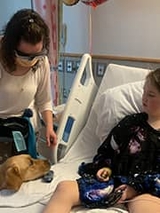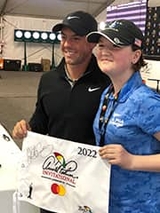Sepsis Treatment and Follow-up Care: Sophia’s Story
Sepsis Treatment and Follow-up Care: Sophia’s Story
Two medevac flights. A 10-hour surgery. Dozens of hours in the car, driving to and from doctor’s appointments. Six hospital stays.
When Mary Moores tells the story of her 14-year-old daughter Sophia’s medical journey, the word “complicated” comes up a lot.

But when describing Sophia herself, another word comes to mind: brave.
“She was asked to do impossible things,” Mary says. “And she did them – again and again.”
Fighting for her life
When Sophia was just 4 weeks old, she was admitted to the hospital for pneumonia – and months later, she was diagnosed with Kostmann’s syndrome, a rare bone marrow disease that placed her at increased risk of infections. For much of her life, the disease was kept in check with daily shots of Neupogen to boost her white blood cell count, and Sophia was able to do the things she loved most: running, golfing with her dad, swimming with her friends, and playing bells in the school marching band.
But that changed in January 2021, when a bout of the flu landed Sophia in a local emergency room.
The next day, her family learned that she had developed sepsis, which is a life-threatening medical emergency triggered by an infection in which the body’s organ systems start to fail.

Sophia spent the next 15 weeks in the hospital, where she battled one infection after another. She also had a bowel perforation that required emergency surgery to repair. Because her bowel was so badly damaged, surgeons created an opening (called an ostomy ileostomy) to bring a section of her small intestine out of the surface of her abdomen to allow the passage of stool and bypass her remaining intestines. This would allow the rest of her intestines to heal because nothing would pass through them.
In July, after doctors at a local pediatric hospital attempted to repair a hole in Sophia’s colon, the head pediatric surgeon suggested Sophia transfer to CHOP so she could be cared for by one of his mentors, Edward Doolin, MD, Director of the Pediatric Colorectal Program.
“Sophia just wasn’t healing,” Mary says. “At CHOP, we felt like we would have a fresh start.”
Cutting-edge treatment for sepsis
The Moores made the three-hour drive from their home in Abbottstown, Pa., to CHOP many times over the next few months to meet with Dr. Doolin and other members of the medical team who were managing Sophia’s care. It was a challenging time: Sophia developed gallstones, and her ostomy site leaked, remaining open because she had several fistulas and drains. The ostomy site was slow to heal, and Sophia required around-the-clock care. She was life-flighted to CHOP twice to receive treatment for new sepsis infections. CHOP's Pediatric Sepsis Program has helped advance the care that patients with sepsis receive.
The Pediatric Sepsis Program was founded in 2017 by Emergency Department physician Fran Balamuth, MD, PhD, and Pediatric Intensive Care Unit physicians Julie Fitzgerald, MD, PhD, and Scott Weiss, MD, MSCE, to improve treatment and follow-up care for infants, children and adolescents with sepsis. The program, which is managed by Christopher Hickey, is leading several National Institutes of Health-funded research projects to transform care for children with sepsis and is finding innovative ways to ensure patients receive the highest-quality care, including developing screening protocols and guidelines for care that have improved outcomes for patients. The Pediatric Sepsis Program also has several quality-improvement initiatives, led by Hannah Stinson, MD, and Mary Kate F. Abbadessa, MSN, RN, ACCNS-P, CPEN, that are critical to delivering outstanding care for children who have sepsis.
Support from a caring team

The Moores were grateful for the medical team’s expertise and compassion throughout their family’s journey. “Dr. Doolin would call me at 6 o’clock at night,” Mary says. “He always followed up to make sure everything Sophia needed was done.” Dr. Doolin was also very attentive to Sophia’s feelings, and would adjust her treatment plan to make sure she was comfortable: “If something was stressing Sophia out,” Mary remembers, “He would say, ‘You’ll do it when you’re ready.’”
Sophia’s medical team also included Beverly Paul, RN, a nurse in the Pediatric Comprehensive Bone Marrow Failure Center, whom Mary describes as her “go-to person,” and Peter Kurre, MD, the center’s director, who always thoughtfully considered what was the safest care for Sophia’s unusual blood disease.
“As a parent, you have a lot of emotion and fears and concerns, and at CHOP there was a willingness and a receptiveness to answer our questions and be patient and sit with us while we were processing the information,” Mary adds. “They genuinely care about the patient and the family, and that gives you the confidence to get through something that is very difficult.”
A life-changing surgery
In September, during one of Sophia’s inpatient stays at CHOP, a surgical team led by Dr. Doolin and David Low, MD, an attending surgeon in the Division of Plastic, Reconstructive and Oral Surgery, reversed her ostomy and removed her gallbladder during a 10-hour procedure.
The surgery was an important milestone for Sophia because it allowed her to do things that aren’t possible with an ostomy, like taking a bath and swimming. Finally, after many months of illness and pain and hospital visits, she could go back home, to the life she loved.
Follow-up care from a team of experts

Sophia started school again in January, several months after coming home from the hospital. And since then, her life has been full of fun activities: She started swimming again, attended a winter dance, and traveled to Orlando to attend the Arnold Palmer Invitational, where she had a golf lesson with PGA Tour player Marc Leishman. The trip was made possible by the Begin Again Foundation, a nonprofit that Leishman founded with his wife, Audrey, to support sepsis patients and raise awareness about the condition.
Sophia and her family first learned about the Begin Again Foundation from Nancy-Ann Kelly, RN, BSN, during one of Sophia’s inpatient stays at CHOP. Kelly is the Nurse Coordinator of the Sepsis Survivorship Program, which helps sepsis survivors and their families overcome any functional, social, cognitive and emotional challenges they may experience after they leave the hospital. Kelly helps educate families about possible lingering effects of sepsis and ensures patients are connected to the resources they need to thrive.
As part of her recovery, Sophia also has regular teletherapy sessions with Lauren Fussner, PhD, a psychologist in the Division of Gastroenterology, Hepatology and Nutrition. “Lauren is phenomenal,” Mary says. “For the longest time, Sophia didn’t want to have any therapy. Lauren is the first person who has been able to form a connection with Sophia so she can process some of the things that have happened.”
Mary is grateful to the CHOP team for the care they have provided, and for giving her and her family the hope they needed to sustain them during the most difficult moments of Sophia’s journey.
“That’s what’s gotten us through,” Mary says. “The hope that not every day would be like today, and that things could be different. That is something we found at CHOP.”